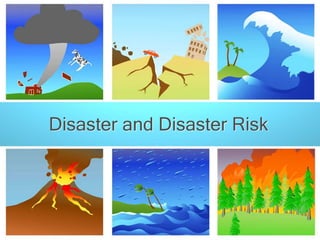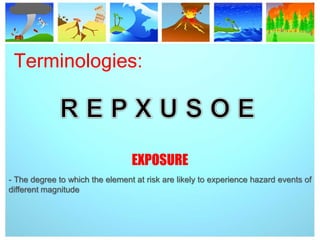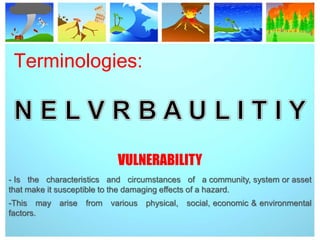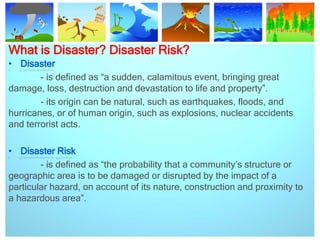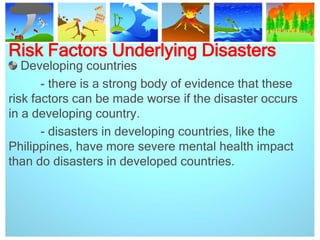- 1. Disaster and Disaster Risk
- 2. Introduction:
• Every year, millions of people around the world are affected
by either human-caused or natural disasters. Disasters take
different forms, like volcanic eruptions, earthquakes, flood,
hurricanes, tornados, or fires.
• In a disaster, people face the danger of death or physical
injury. They may also lose their home, possessions, and
community where they live in. Disasters can cause a full
range of mental and physical reactions. Those affected may
also react to problems that occur after the event, as well as
to triggers or reminders of the trauma.
- 3. Terminologies:
HAZARD
-Is a dangerous phenomenon, substance, human activity or condition that may
cause loss of life, injury or other health impacts, property damage, loss of
livelihood & services, social & economic disruption or environmental damage...
-Could be a potentially damaging phenomenon
-It could be natural or human-induced.
- 4. Terminologies:
EXPOSURE
- The degree to which the element at risk are likely to experience hazard events of
different magnitude
- 5. Terminologies:
VULNERABILITY
- Is the characteristics and circumstances of a community, system or asset
that make it susceptible to the damaging effects of a hazard.
-This may arise from various physical, social, economic & environmental
factors.
- 6. Terminologies:
CAPACITY
- Is the combination of all strengths and resources available within the community,
society or organization that can reduce the level of risk or effects of a disaster.
- 7. Terminologies:
RISK
- Is the combination of Probability of an event to happen and its negative
consequences...
.
R =
HAZARD x VULNERABILITY (exposure)
CAPACITY
- 8. What is Disaster? Disaster Risk?
• Disaster
- is defined as “a sudden, calamitous event, bringing great
damage, loss, destruction and devastation to life and property”.
- its origin can be natural, such as earthquakes, floods, and
hurricanes, or of human origin, such as explosions, nuclear accidents
and terrorist acts.
• Disaster Risk
- is defined as “the probability that a community’s structure or
geographic area is to be damaged or disrupted by the impact of a
particular hazard, on account of its nature, construction and proximity to
a hazardous area”.
- 9. Types of Disasters
• Natural disasters
- these originates from the different “forces” of nature
(geological, meteorological, hydrometeorological and
biological.
Agricultural diseases and pests
Storm Surge
Drought and water shortage – El Niño
Earthquakes
Hurricanes and tropical storms
Landslides and debris flow
Tornadoes
Tsunamis
- 10. Types of Disasters
• Human-made and Technological Types of Disasters
- these disasters occur due to people’s actions against
human, material and environment. These include transport and
industrial accidents
Hazardous materials
Power service disruption and blackout
Nuclear power plant and nuclear blast
Radiological emergencies
Chemical threat and biological weapons
Cyber attack
Explosions
Civil unrest
- 11. Risk Factors Underlying Disasters
A number of factors make it
more likely that those affected
will have more severe or longer-
lasting stress reactions after
disasters.
- 12. Risk Factors Underlying Disasters
Severity of exposure
- the amount of exposure to the disaster is
highly related to risk of future mental problems.
- at higher risk are those that go through
the disaster themselves.
-next are those in close contact with
victims.
- at lower risk of lasting impact are those
who only had indirect exposure, such as news of the
severe damage.
- 13. Risk Factors Underlying Disasters
Gender and family
- Almost always, women or girls suffer more
negative effects than do men or boys.
- Disaster recovery is more stressful when
children are present in the home.
- Women with spouses also experience more
distress during recovery.
- 14. Risk Factors Underlying Disasters
Age
- adults who are in the age range of 40-60 are
likely to be more distressed after disasters.
- the thinking is that if one is in that age range,
he/she has more demands from job and family.
- in general, children show more severe distress
after disasters than do adults. Higher stress in the
parents is related to worse recovery in children.
- 15. Risk Factors Underlying Disasters
Developing countries
- there is a strong body of evidence that these
risk factors can be made worse if the disaster occurs
in a developing country.
- disasters in developing countries, like the
Philippines, have more severe mental health impact
than do disasters in developed countries.
- 16. Risk Factors Underlying Disasters
Low or negative social support
- the support of others can be both a risk and a
resilience factor. Social support can weaken after
disasters. This may be due to stress and the need for
members of the support network to get on with their
own lives.
- 17. Effects of Natural Disasters on Human Life
Displaced populations
Health risks
Food scarcity
Emotional aftershocks
-PTSD (post-traumatic stress disorder)

